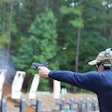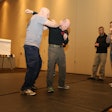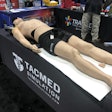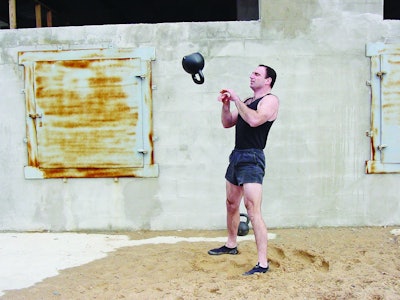 Jeff Martone of Tactical Athlete performs high-intensity kettlebell swing and catch exercises. Photo: Jeff Martone
Jeff Martone of Tactical Athlete performs high-intensity kettlebell swing and catch exercises. Photo: Jeff Martone
In my last POLICE Magazine article, "Get Comfortable Being Uncomfortable," I discussed why we need to incorporate high-intensity workouts into our daily routines as law enforcement officers. In a nutshell, I said that our workouts need to be varied, intense, and contain functional movements so that we can build the physical and mental stamina that is necessary to succeed in a job that is varied, intense, and requires functional movement.
I also offered tips for starting the process of building high-intensity workouts into your routine. Now I will add my most important tip to this list: Just get it done!
In order to help you get it done, I have come up with PATROL as an acronym for the elements that you need for planning and maximizing your workouts. PATROL will help you to program your daily workouts and stay healthy.
(P) Pick a Time
With the challenging schedules that are part of the law enforcement profession, picking the right time to train can be difficult. It is imperative that you choose a time that will serve you well and benefit you both on and off the job. Once you choose a time when you consistently enjoy training, stick with it. Consistency is king.
Some officers train before work because it serves as a warm-up before hitting the streets. I can't think of a better way to ready your body for the mental, emotional, and physical rigors of the job. In addition, research has shown that high-intensity physical training is good for your brain because it increases blood flow. But, there are other officers who never miss a training session after work because it serves as a great stress reliever.
Exercising after work has served many of my colleagues well. However, if you're fortunate enough to work for a department that allows you to train on duty… Do it!
Once you have developed the discipline to train consistently four to five days a week and your high-intensity workouts have become an essential part of your regular routine, then you can vary the time of day for your workouts.
(A) Assess
Assess your fitness needs and readiness before each workout. In order to design and plan your workout of the day, you must make a thorough and critical assessment of your current fitness level, goals, strengths, areas that need improvement, and readiness. You also must take into consideration what you did for a workout the day before. Once you have made these assessments, you can design your workout of the day and train accordingly.
(T) Train
There are many types of training philosophies and methods. For example, high level trainers suggest a 3 days on/1 day off schedule. This method can apply to hard, moderate, or low impact training days followed by mobility/recovery days. Remember, your current level of readiness will determine the level of intensity of your "on" days.
Also, when selecting how you want to train, ask yourself if your training method will prepare you for foot pursuits and violent altercations, if it will strengthen your body and your mind and if it will it make you functional and healthy.
Then, no matter what training method you choose, always possess a sense of urgency when you work out. Train as though your life depends on it because it absolutely does.
(R) Rotation
To be functional and successful in both your on-duty and off-duty life, you need to be able to rotate. However, most exercises are linear in fashion. Think about your favorite exercises for one moment – push presses, pull ups, box jumps, etc. They all share a linear movement. That's OK. However, life and police work are both asymmetrical so we need the ability to move and respond accordingly.
Therefore, add some prudent, rotational movements to your training regimen once a week. Strike a heavy bag with combinations, play a round of golf, go to the driving range, throw a ball, play softball, etc. This can be fun and energizing. But, you also can use your rotational movement training to push the limits of your fitness. For example, striking a heavy bag at a high tempo and frequency forges elite fitness while also promoting rotational movements.
(O) One
While training, you need to stay centered and focused on one rep, one movement, one combination at a time. This does not mean that you need to be too robotic or too deliberate. You can still go fast. You can still train hard. You just need to master each repetition by placing an emphasis on proper form.
Whether you're pushing iron or firing off a furious striking combination on a heavy bag, your form should be impeccable. Execute one proper movement at a time.
(L) Listen
Listen to your body. It bears repeating. Listen to your body. If something feels out of the ordinary or if something hurts, you have options. Adjust your workout, focus on another area, or shut the workout down. Live to train another day. Your body will thank you both sooner and later.
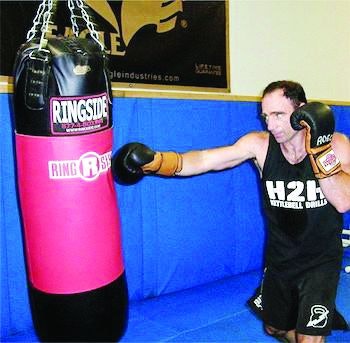 Always possess a sense of urgency when you work out. Train as though your life depends on it because it absolutely does. Photo: Jeff Martone
Always possess a sense of urgency when you work out. Train as though your life depends on it because it absolutely does. Photo: Jeff Martone
We all have friends who've pushed through a workout while dealing with a potential injury. What happens? They end up losing invaluable training time while dealing with unnecessary injuries. Listening to your body will always keep you moving forward and toward your athletic potential.
Sample Workouts
With the acronym PATROL in mind, here are two sample workouts to kick-start your high-intensity training. As always, please consult your doctor before starting any new exercise program.
Workout #1: Half Cindy
(CrossFit workout named "Cindy" scaled to 10 minutes)
Complete as many rounds in 10 minutes as you can of:
• 5 pull-ups
• 10 push-ups
• 15 squats
Scale the workout to your current fitness level.
Workout #2: "Fight Day" Workout
Do 3 rounds of the following:
• 2 minutes on the heavy bag (shadow fight if no heavy bag)
• 20 kettlebell swings (air squats if you don't have a kettlebell)
• 25 elevated push-ups (feet on a chair)
• 400-meter run
Scale the workout to your current fitness level.
Melissa Ryan assisted in the preparation and writing of this article.
George Ryan is a sergeant with a major Southern California agency. He spent 17 years in SWAT, and he created his department's Peak Performance and Recovery Training program.








